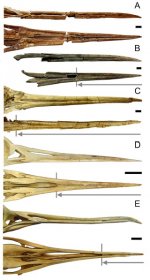Fred Ruhe
Well-known member

Martín Chávez-Hoffmeister, 2020
Bill disparity and feeding strategies among fossil and modern penguins
Paleobiology. in press.
doi:10.1017/pab.2020.10
Abstract: https://www.cambridge.org/core/jour...rn-penguins/F2BB8378F8C034A32CAA02D050E48E5E#
One of the most remarkable differences between Paleogene penguins and their living relatives is the shape and length of their beaks. Many of the Eocene and Oligocene penguins have a thin and elongated spear-like bill, which contrasts with the proportionally shorter and more robust bill of most living species. These differences suggest an important shift in their feeding strategies. This study explores the morphological disparity on the skull of penguins, emphasizing bill morphology and it relationship with feeding habits. For this, the skulls of 118 species of aquatic birds, including 21 fossil and living penguins, were analyzed using two-dimensional geometric morphometric. The results show that, unlike what has been reported for modern birds overall, in penguins and Aequornithes, bill elongation is related to a reduction of the braincase. The discriminant analysis shows that there are significant differences between penguins that feed near or far from the coast and between those that consume nectonic and planktonic prey, identifying Madrynornis as the only extinct form with a possibly planktonic diet. Additionally, it is clear that Paleogene penguins occupy a region of morphospace unexplored by most diving birds, with the western grebe being their closest modern analogue. This is consistent with the hypothesis that giant penguins hunted by harpooning and not by biting as living forms do, signaling a significant change in the habits of those birds leading to the emergence of their crown group.
Enjoy,
Fred
Bill disparity and feeding strategies among fossil and modern penguins
Paleobiology. in press.
doi:10.1017/pab.2020.10
Abstract: https://www.cambridge.org/core/jour...rn-penguins/F2BB8378F8C034A32CAA02D050E48E5E#
One of the most remarkable differences between Paleogene penguins and their living relatives is the shape and length of their beaks. Many of the Eocene and Oligocene penguins have a thin and elongated spear-like bill, which contrasts with the proportionally shorter and more robust bill of most living species. These differences suggest an important shift in their feeding strategies. This study explores the morphological disparity on the skull of penguins, emphasizing bill morphology and it relationship with feeding habits. For this, the skulls of 118 species of aquatic birds, including 21 fossil and living penguins, were analyzed using two-dimensional geometric morphometric. The results show that, unlike what has been reported for modern birds overall, in penguins and Aequornithes, bill elongation is related to a reduction of the braincase. The discriminant analysis shows that there are significant differences between penguins that feed near or far from the coast and between those that consume nectonic and planktonic prey, identifying Madrynornis as the only extinct form with a possibly planktonic diet. Additionally, it is clear that Paleogene penguins occupy a region of morphospace unexplored by most diving birds, with the western grebe being their closest modern analogue. This is consistent with the hypothesis that giant penguins hunted by harpooning and not by biting as living forms do, signaling a significant change in the habits of those birds leading to the emergence of their crown group.
Enjoy,
Fred




